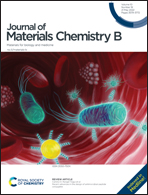Bottlebrush copolymers for gene delivery: influence of architecture, charge density, and backbone length on transfection efficiency†
Abstract
The influence of polymer architecture of polycations on their ability to transfect mammalian cells is probed. Polymer bottle brushes with grafts made from partially hydrolysed poly(2-ethyl-2-oxazoline) are used while varying the length of the polymer backbone as well as the degree of hydrolysis (cationic charge content). Polyplex formation is investigated via gel electrophoresis, dye-displacement and dynamic light scattering. Bottle brushes show a superior ability to complex pDNA when compared to linear copolymers. Also, nucleic acid release was found to be improved by a graft architecture. Polyplexes based on bottle brush copolymers showed an elongated shape in transmission electron microscopy images. The cytotoxicity against mammalian cells is drastically reduced when a graft architecture is used instead of linear copolymers. Moreover, the best-performing bottle brush copolymer showed a transfection ability comparable with that of linear poly(ethylenimine), the gold standard of polymeric transfection agents, which is used as positive control. In combination with their markedly lowered cytotoxicity, cationic bottle brush copolymers are therefore shown to be a highly promising class of gene delivery vectors.

- This article is part of the themed collection: Celebrating our 2024 Prizewinners


 Please wait while we load your content...
Please wait while we load your content...